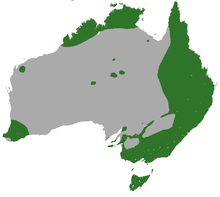| Minang | Koomal |
|---|---|
| English | Common Brushtail Possum |
Kelang and Koomal are both names for what in English is called the Common Brushtail Possum, or simply the Brushtail Possum. Koomal's scientific name is Trichosurus vulpecula and it belongs to the scientific suborder Phalangeriformes. The sub-species in Noongar Boodjar is Trichosurus vulpecula hypoleucus.[1] Koomal is a nocturnal, semi-arboreal marsupial, it is native to Australia, and its conservation status is "Least Concern".[2]


It is the Australian marsupial most often seen by city-dwellers, as it is one of few that thrives in cities as well as a wide range of natural and human-modified environments. Around human habitations, Koomal is an inventive and determined forager with a liking for fruit trees, vegetable gardens, and kitchen raids.
Koomal was introduced to New Zealand in the 1850s to establish a fur industry, but in the mild subtropical climate of New Zealand, and with few to no natural predators, it thrived to the extent that it became a major agricultural and conservation pest.
The name possum derives from the resemblance to the opossums of the Americas (the term comes from Powhatan language 'aposoum' meaning "white animal". However, although opossums are also marsupials, Australasian possums are more closely related to other Australasian marsupials such as Yonga.
Habitat
editOn Barrow Island they live on the ground where there are no trees. In cities, possums often seek shelter, warmth and protection in the dark recesses of buildings. A favoured spot is between the ceiling and the roof and this can be a problem to some people. The Brushtail Possum remains restricted to tree hollows in areas where foxes occur.[1] [3]
Kelang/Koomal Waarnk - Stories about the Common Brushtail Possum
edit- See the NoongarPedia page section Wp/nys/Noongar yarns of Minang region#The Waitch, the Chudic and the Coomal
Ngearn waarnk
edit- ↑ 1.0 1.1 "Brushtail Possum". Fauna Profiles. Dept. of Environment and Conservation. WA Govt. Retrieved 1 February 2019
- ↑ "Common Brushtail Possum". IUCN Red List of Threatened Species. Retrieved 1 February 2019
- ↑ "MAMMALS - COMMON BRUSHTAIL POSSUM". Australia ZOO. Retrieved 1 February 2019